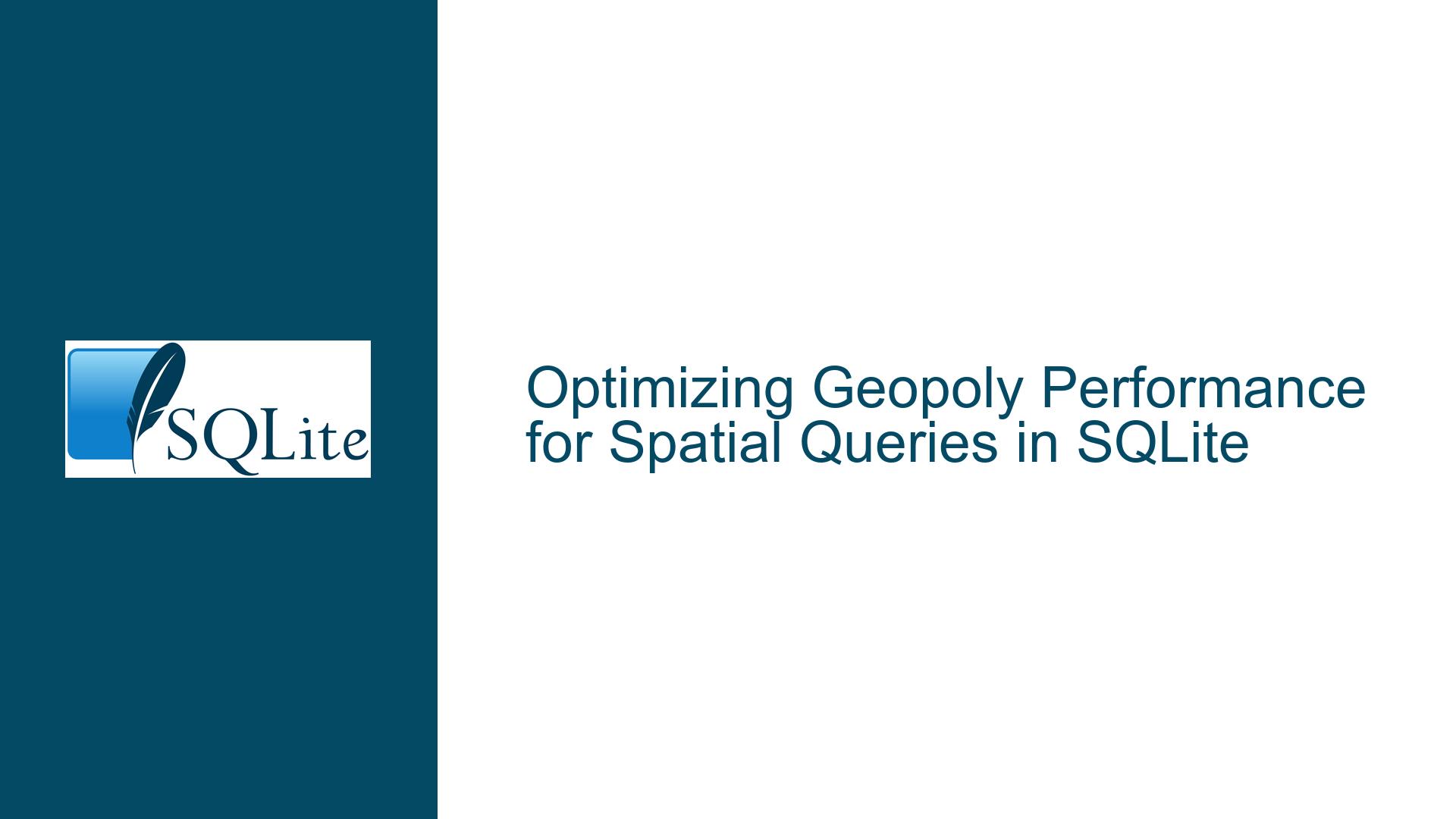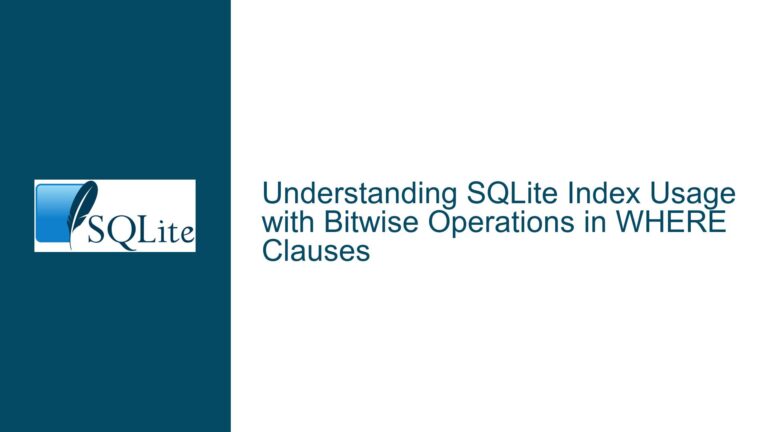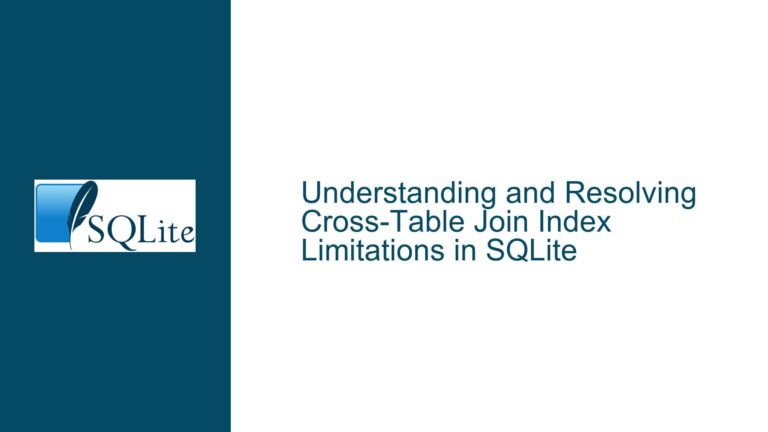Optimizing Geopoly Performance for Spatial Queries in SQLite
Geopoly Query Performance Degradation Compared to Simple BETWEEN Joins
When working with geospatial data in SQLite, the geopoly extension provides a powerful way to handle complex spatial queries, such as finding all points within a specific radius of a given location. However, in some cases, the performance of geopoly queries can be significantly slower compared to simpler queries using BETWEEN clauses on latitude and longitude columns. This performance degradation can be particularly pronounced when dealing with large datasets or complex polygons.
In the provided scenario, the user has two tables: a and b. Table a contains a list of unique identifiers (a_id), while table b contains related data, including latitude (lat) and longitude (lon) values. The user has created a virtual table vloc using the geopoly extension, which stores polygons generated around each point in table b. The goal is to find all rows in table a within a certain distance (e.g., 10 kilometers) of a given point. The user observes that while the geopoly query returns results that are close enough to the expected output, it takes significantly longer to execute compared to a simple BETWEEN query on the latitude and longitude columns.
The performance discrepancy is further exacerbated when using more complex polygons, such as circles generated with a higher number of sides. For example, when using geopoly_regular(0, 0, 0.1, 20) to generate a 20-sided polygon, the query execution time increases from 0.400 seconds to 0.636 seconds. This suggests that the complexity of the polygon directly impacts the performance of the geopoly query.
Complexity of Polygon Shapes and Index Utilization
One of the primary reasons for the performance degradation in geopoly queries is the complexity of the polygon shapes being used. The geopoly extension is designed to handle complex spatial queries, but it does so by performing computationally intensive operations on the polygon shapes. When the polygons are simple (e.g., triangles with a small number of sides), the performance impact is relatively minor. However, as the complexity of the polygons increases (e.g., circles with a higher number of sides), the computational overhead also increases, leading to slower query execution times.
Another factor contributing to the performance degradation is the lack of efficient index utilization. In the case of the BETWEEN query, SQLite can leverage the inherent order of the latitude and longitude columns to quickly filter out rows that fall outside the specified range. This allows the query to execute much faster, as the database engine can skip over large portions of the data that do not meet the criteria.
In contrast, the geopoly extension does not have the same level of index optimization for spatial queries. While geopoly does support spatial indexing, the indexing mechanism is not as efficient as the traditional B-tree indexes used for numeric columns. As a result, the geopoly query has to perform more extensive computations to determine whether each polygon falls within the specified range, leading to slower execution times.
Additionally, the geopoly extension is designed to handle a wide range of spatial operations, including complex intersections and unions. This flexibility comes at the cost of performance, as the extension must account for a variety of edge cases and potential geometric complexities. In contrast, the BETWEEN query is much simpler and can be optimized more effectively by the SQLite query planner.
Strategies for Improving Geopoly Query Performance
To improve the performance of geopoly queries, several strategies can be employed. These strategies focus on reducing the complexity of the polygon shapes, optimizing the use of spatial indexes, and leveraging alternative approaches for spatial queries.
Simplifying Polygon Shapes
One of the most effective ways to improve the performance of geopoly queries is to simplify the polygon shapes used in the queries. In the provided scenario, the user is generating polygons with a small delta of 0.0001 degrees, which results in very small triangles. While these triangles are sufficient for representing points, they may not be necessary for the specific use case of finding points within a certain radius.
Instead of using small triangles, the user could consider using simpler shapes, such as squares or rectangles, which are easier for the geopoly extension to process. For example, instead of generating a triangle with a delta of 0.0001 degrees, the user could generate a square with a side length of 0.0001 degrees. This would reduce the complexity of the polygon while still providing a reasonable approximation of the point.
Additionally, when generating circles for spatial queries, the user should consider using a lower number of sides for the polygon. For example, instead of using a 20-sided polygon to approximate a circle, the user could use an 8-sided polygon. This would significantly reduce the computational overhead of the query while still providing a reasonable approximation of the circle.
Optimizing Spatial Indexes
Another strategy for improving geopoly query performance is to optimize the use of spatial indexes. While the geopoly extension does not support traditional B-tree indexes, it does provide a mechanism for spatial indexing through the use of the rtree module. The rtree module allows the user to create spatial indexes on the polygons stored in the geopoly table, which can significantly improve query performance.
To create an rtree index on the vloc table, the user can use the following SQL command:
CREATE VIRTUAL TABLE vloc_rtree USING rtree(a_id, b_id, minX, maxX, minY, maxY);
This command creates an rtree index on the vloc table, with the minX, maxX, minY, and maxY columns representing the bounding box of each polygon. Once the rtree index is created, the user can rewrite the geopoly query to take advantage of the spatial index:
SELECT DISTINCT a_id FROM vloc_rtree WHERE minX <= 0.1 AND maxX >= -0.1 AND minY <= 0.1 AND maxY >= -0.1;
This query uses the rtree index to quickly filter out polygons that do not intersect with the specified bounding box, reducing the number of polygons that need to be processed by the geopoly_within function. This can significantly improve query performance, especially for large datasets.
Leveraging Alternative Approaches for Spatial Queries
In some cases, it may be more efficient to use alternative approaches for spatial queries, rather than relying on the geopoly extension. For example, if the primary use case is to find points within a certain radius of a given location, the user could consider using a combination of BETWEEN queries and the Haversine formula to calculate distances.
The Haversine formula is a well-known algorithm for calculating the distance between two points on the surface of a sphere, given their latitude and longitude. By combining the BETWEEN query with the Haversine formula, the user can achieve similar results to the geopoly query, but with significantly better performance.
For example, the user could rewrite the query as follows:
SELECT DISTINCT a.a_id
FROM a
JOIN b ON a.a_id = b.a_id
WHERE lat BETWEEN -0.1 AND 0.1
AND lon BETWEEN -0.1 AND 0.1
AND (6371 * acos(cos(radians(0)) * cos(radians(lat)) * cos(radians(lon) - radians(0)) + sin(radians(0)) * sin(radians(lat)))) <= 10;
In this query, the BETWEEN clause is used to quickly filter out points that are outside the specified latitude and longitude range, while the Haversine formula is used to calculate the distance between the remaining points and the given location. This approach can be significantly faster than using the geopoly extension, especially for large datasets.
Conclusion
The performance degradation observed in geopoly queries compared to simple BETWEEN joins can be attributed to the complexity of the polygon shapes and the lack of efficient index utilization. By simplifying the polygon shapes, optimizing the use of spatial indexes, and leveraging alternative approaches for spatial queries, it is possible to significantly improve the performance of geopoly queries in SQLite. These strategies can help users achieve the desired spatial query results while maintaining acceptable performance levels, even for large datasets.






